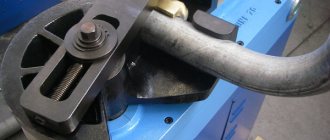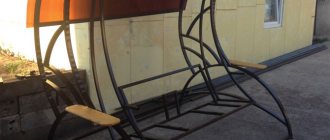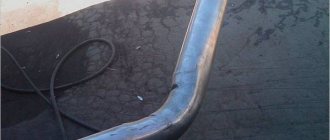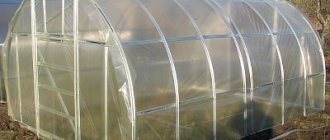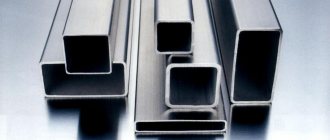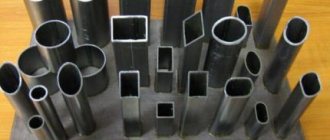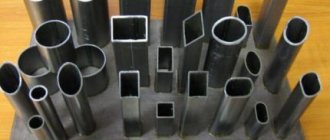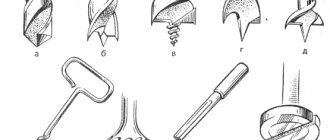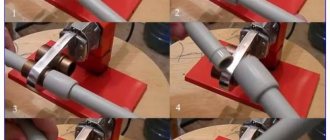Published
08.08.2018 |
Author: kmveg 0
When performing any actions with metal, certain skill and special tools are required. Giving the desired shape to an aluminum sheet within an hour is necessary for repair and installation work.
To bend an aluminum sheet, it is necessary to perform several operations so that the resulting sheet takes the required shape. In this case, welding work is not carried out, which changes the structure of the metal and negatively affects the durability of the part.
In order to bend an aluminum sheet, special equipment is needed. Even if you carry out such an operation at home, such manipulations are still not carried out only with your hands.
Methods
When aluminum is processed on a production scale, it is bent in two ways.
- Free. At the moment of bending the metal, there is an air gap between the sheet and the pressing apparatus. This method allows you to work with thicker materials and produce products with complex shapes, but when working with thin sheets it gives low bending accuracy.
- Calibration. In this case, there is no air layer between the device and the aluminum. This allows you to accurately bend thin sheets, but requires a lot of effort and expensive equipment.
You can bend a sheet of aluminum at home without using expensive tools.
Bending at home
The most common and proven method of household bending of aluminum is cutting grooves. This gives high angular accuracy and allows you to work with materials of different thicknesses.
- The bend location is marked on the aluminum sheet in accordance with the measurements.
- Guides are fixed along the lines - iron corners, profiles, sheets of harder metal are suitable.
- According to the applied markings, an incision is made with a depth of approximately half the thickness of the sheet itself. Cut along the outside of the fold. Most often this is done using a router, but on small thin sheets you can get by with a sharp construction knife.
- After the cut is ready, they begin to bend the sheet without removing the guides. Do this carefully and gradually along the entire length of the marking until the desired angle is reached.
Possible problems
Since aluminum is not produced in its pure form and is only part of alloys, its different grades bend differently depending on the properties of the accompanying substances.
Technical alloys bend best. They correspond to brands 1105 and VD1. They are light, easy to cut, bend well, but are easy to damage in the process. Aluminum-magnesium alloys labeled AMG also bend well, but have higher strength. They are adapted for simple linear bends; it is impossible to make a complex shape from them. For this purpose there are plastic alloys marked AMC. They are made specifically to create complex shapes, but they are a little more difficult to cut at home. Doralumin, marked with the letter D, and aircraft alloys are completely unbendable without the use of special devices.
Despite the ductility of aluminum, bending sheets of its alloy requires certain skills. Therefore, before you start bending the future product, it is worth practicing on unnecessary scraps and making sure that the selected material is subject to deformation.
Source
Characteristics and properties of the tire
The demand for aluminum tires is due to the positive properties and characteristics of the product:
- has high resistance to corrosion, and throughout the entire service life, which is 25 years, this property remains unchanged;
- excellent electrical conductive material;
- characterized by light weight;
- plastic material, which makes it possible to use it in conductors and distribution panels;
- often used for decorative finishing of equipment due to its good appearance.
How to bend aluminum sheet at home
When performing any actions with metal, certain skill and special tools are required. Giving the desired shape to an aluminum sheet within an hour is necessary for repair and installation work.
To bend an aluminum sheet, it is necessary to perform several operations so that the resulting sheet takes the required shape. In this case, welding work is not carried out, which changes the structure of the metal and negatively affects the durability of the part.
In order to bend an aluminum sheet, special equipment is needed. Even if you carry out such an operation at home, such manipulations are still not carried out only with your hands.
Should be considered
That when bending, the metal is stretched from the outer edge of the product and is seated or compacted from the inner edge of the bend. This technique of manipulating an aluminum sheet changes the structure of the metal, which worsens its technical characteristics.
Modern industry very rarely produces aluminum in its pure form; most likely it is various alloys, such as aluminum - magnesium, food grade. Each of them is used in a different area and requires different processing techniques.
Specifics of bending aluminum sheet
It is easy to bend an aluminum sheet, and if you need to heat it up, its melting point is not very high. But it's not that simple. About everything in order.
At first glance, there is no more convenient material than aluminum sheet for creating a wide variety of shapes with your own hands. Aluminum is easy to bend, and if you need to heat it up, its melting point is not very high. But it's not that simple. In practice, bending an aluminum sheet has certain specifics both in the bending process itself and in maintaining the integrity of the sheet material at the point of deformation.
To come in
Already registered? Sign in here.
There are currently 0 users on the page
There are no users viewing this page
Source cccp3d.ru
We need advice from the collective wisdom. Given: 5 aluminum tire plates. It is necessary to bend them. How to bend is shown in the picture. Do not offer a vice or hammer.
What's special about aluminum bending
There are mainly two methods of bending aluminum sheet material:
- air or free,
- calibration
The free method is when there is an air gap between the punch and the sheet of metal. This method is the most widely used today.
If during the bending process there is no air gap between the punch and the walls of the mold and the aluminum sheet is tightly compressed, then this method is called calibration. This technique is quite old and is used for the softest materials or for the manufacture of complex shapes of products.
Bending aluminum using the free method has a number of advantages compared to the calibration method, namely:
- a higher degree of flexibility, so without replacing the punch and mold, you can obtain different bending angles of the sheet profile;
- less effort is required to effect deformation;
- You can bend sheets of greater thickness;
- comparatively lower cost of equipment.
The disadvantages of the free method include:
- low accuracy of angles when bending for thin-walled metal sheets;
- the accuracy of the repetition of the shape depends on the physical properties of the material;
- poor applicability for operations with complex configurations.
Equipment classification
For different methods of bending aluminum sheets, special equipment is used. To facilitate the deformation of the metal, it can be preheated. All sheet benders are divided into two large groups, which need to be discussed in more detail.
Hand tools
Stationary equipment
This group includes industrial machines that are installed in enterprises. Used for serial production of parts from metal sheets. They have a stable base and are electrically or hydraulically driven.
The disadvantage of stationary mechanisms is that they take up a lot of space and require additional effort during transportation. However, industrial machines allow you to work with metal sheets of large thickness.
Portable equipment
Compact designs that can be used in a variety of conditions. Do not require additional skills when working. The disadvantage of portable devices is the inability to work with thick sheets of metal.
Which brands can be bent and which cannot?
Thus, we can distinguish several main types of rolled aluminum sheets, which can differ significantly from each other in their physical properties and deformation capabilities. So, the most common types:
- Annealed , has the letter M in its designation, is the softest grade, therefore it is perfectly amenable to deformation, but at the same time easily wrinkles and breaks when overextended.
- Semi-hardened is designated as H2 and has more rigid properties than grade M; it also deforms well and is able to withstand bending over 90 degrees at a time. At the same time, due to its increased rigidity, it retains its shape well and prevents the formation of dents, therefore it is most often used as a facing material.
- Cold-worked , the grade designation contains one letter H. Cold-working is a method of imparting increased strength to sheet metal using cold compaction. To do this, the aluminum sheet is additionally rolled between two shafts on a special machine. This variety bends well at angles up to 90 degrees and is able to withstand significant loads on its surface.
- Hardened or naturally aged, as a rule, is marked with the letter T. It is a fairly hard rolled aluminum product, so it is more demanding when processing, since when cold bent at 90 degrees, it cracks at the bend. Used for the manufacture of parts and assemblies operating under increased load.
The main types of rolled aluminum alloys produced can be arranged as follows:
- Technical alloys of grades 1105 and VD1 have a relatively low specific weight of the sheet and are easily bent without any problems.
- Aluminum-magnesium alloys are marked with the letters AMG. They are made from aluminum alloyed with the addition of magnesium and manganese. The AMG brand has acid-resistant properties and bends well, so it is mainly used for the production of containers and tanks, as well as parts for boats and boats.
- Food alloys of grades A5 and AD are produced in cold-worked, semi-hardened or annealed grades.
- AMC alloys with increased ductility are specially designed for the manufacture of complexly curved parts, such as car radiators, etc.
- Duralumin is marked with the letter D. It is a high-strength grade, the main difference of which is its high resistance to external influences. Duralumin practically does not bend, therefore it is used only in the manufacture of parts by stamping.
- Aviation especially strong grade B alloys are bent using a special stamping and pressing technology. They are used in the manufacture of highly loaded parts in the automotive and aircraft industries.
The properties and characteristics of the produced grades and types of rolled aluminum sheets are described in more detail in GOST 21631-76.
Tags: aluminum, trunk, fastenings.
Comments 106
I would mill it and boil it afterwards. Judging by the thickness, the force on them will be great, in this case I would rather replace it with metal. In my opinion, in any case, aluminum that is then heated at the point of bending and heating will weaken and fail sooner or later. .
according to the USSR textbook. All bending radii for basic materials and thicknesses are specified there.
Find where you have a metal shop. Surely there is a bending machine there and that’s the whole problem. And do it yourself such a machine with corners and simple hinges like those used on garage doors.
I read all the advice and realized that in practice, few people have worked with flexible aluminum and its alloys. In fact, such plates bend very easily, but they must first be hardened. Just like copper, by the way. And now in more detail: 1. Heat the aluminum part until it glows very lightly. It’s better to heat in a dimly lit room (it’s easier to see the glow), because, as someone here already said, aluminum is easy to overheat and melt. To see this boundary (light glow - melt), first practice on any unnecessary aluminum part. 2. As soon as the aluminum warms up, throw it into water and cool completely. 3. You take it out of the water and bend it as you need, either in a yew through soft spacers (wood, textolite, etc.), or in any other device. When hardened, aluminum and materials based on it become very plastic and bend much easier than without heat treatment. But there is one nuance here. Aluminum (like copper) self-tempers very quickly. And after about 2-3 hours it will become noticeably stiffer, and to deform it you will have to harden it again. Good luck!
I read all the advice and realized that in practice, few people have worked with flexible aluminum and its alloys. In fact, such plates bend very easily, but they must first be hardened. Just like copper, by the way. And now in more detail: 1. Heat the aluminum part until it glows very lightly. It’s better to heat in a dimly lit room (it’s easier to see the glow), because, as someone here already said, aluminum is easy to overheat and melt. To see this boundary (light glow - melt), first practice on any unnecessary aluminum part. 2. As soon as the aluminum warms up, throw it into water and cool completely. 3. You take it out of the water and bend it as you need, either in a yew through soft spacers (wood, textolite, etc.), or in any other device. When hardened, aluminum and materials based on it become very plastic and bend much easier than without heat treatment. But there is one nuance here. Aluminum (like copper) self-tempers very quickly. And after about 2-3 hours it will become noticeably stiffer, and to deform it you will have to harden it again. Good luck!
